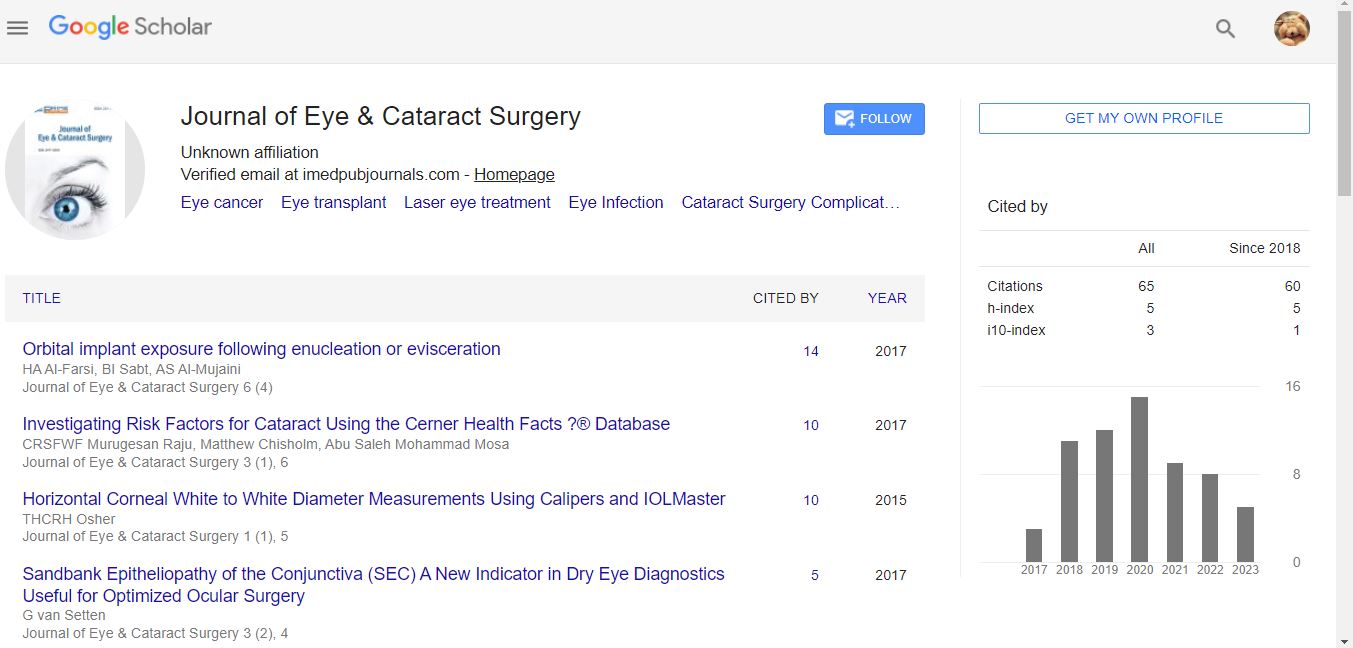Commentry - (2024) Volume 10, Issue 2
Navigating the World of Corneal Flap Surgery: Understanding Your Options
Nathan Alexander*
Department of Ophthalmology, Columbia University, USA
*Correspondence:
Nathan Alexander,
Department of Ophthalmology, Columbia University,
USA,
Email:
Received: 29-May-2024, Manuscript No. IPJECS-24-20645;
Editor assigned: 31-May-2024, Pre QC No. IPJECS-24-20645 (PQ);
Reviewed: 14-Jun-2024, QC No. IPJECS-24-20645;
Revised: 19-Jun-2024, Manuscript No. IPJECS-24-20645 (R);
Published:
26-Jun-2024, DOI: 10.36648/2471-8300.10.2.14
Description
This procedure aims to correct refractive errors such as myopia,
hyperopia, and astigmatism. Understanding the intricacies of the
corneal flap process is essential for both patients and medical
professionals. The cornea is the eye’s outermost layer, comprising
five layers: the epithelium, Bowman’s layer, stroma, Descemet’s
membrane, and endothelium. The stroma, constituting about
90% of the cornea’s thickness, is primarily reshaped during
refractive surgery. The corneal flap is created by cutting through
the epithelium and Bowman’s layer, reaching into the stroma.
The primary purpose of creating a corneal flap is to allow precise
reshaping of the corneal stroma while preserving the integrity
of the upper corneal layers. By temporarily lifting the flap,
surgeons can access the stromal tissue for ablation using an
excimer laser. This method offers several advantages, including
quicker recovery times and reduced post-operative discomfort
compared to surface ablation techniques like photorefractive
keratectomy. The traditional method for creating a corneal flap
involves using a mechanical device called a microkeratome.
This device features a high-speed oscillating blade that makes
a precise, circular incision in the cornea. The microkeratome
technique is known for its reliability and has been used since
the inception of surgery. A more recent advancement in corneal
flap creation is the femtosecond laser. This laser uses ultrafast
pulses to create a flap by photodisrupting corneal tissue at a
microscopic level. The femtosecond laser offers greater precision
and customization in flap thickness, diameter, and hinge
position. It also reduces the risk of complications associated
with mechanical microkeratomes, such as incomplete or
irregular flaps. Patients undergoing with a corneal flap typically
experience rapid visual recovery. Most can return to normal
activities within a day or two post-surgery. The corneal flap acts
as a natural bandage, promoting faster healing and reducing
the risk of infection. The creation of a corneal flap minimizes
disruption to the corneal surface, leading to less post-operative
pain and discomfort compared to surface ablation procedures.
Patients often report mild irritation or dryness, which resolves
within a few days. The corneal flap allows for more precise
ablation of the stromal tissue, improving the accuracy of
refractive error correction. This precision results in better visual
outcomes and a higher likelihood of achieving the desired
refractive result. One potential complication of the corneal flap
is flap dislocation or displacement, particularly in the early postoperative
period. Patients are advised to avoid rubbing their
eyes and to follow post-operative care instructions carefully to
minimize this risk. Epithelial ingrowth occurs when epithelial
cells migrate under the corneal flap, potentially causing visual
disturbances or discomfort. This condition is typically monitored
during follow-up visits and can be treated if necessary. Flap
striae are fine wrinkles that can form in the corneal flap,
leading to visual disturbances. These striae may require surgical
intervention to smooth out the flap and restore clear vision.
The corneal flap is a vital aspect of modern refractive surgery,
offering numerous benefits, including rapid recovery, reduced
discomfort, and enhanced precision. While there are potential
complications, advancements in technology, particularly the
use of femtosecond lasers, have significantly improved the
safety and efficacy of the procedure. Understanding the corneal
flap’s role and potential risks can help patients make informed
decisions about their refractive surgery options.
Acknowledgement
None.
Conflict Of Interest
None.
Citation: Alexander N (2024) Navigating the World of Corneal Flap Surgery: Understanding your Options. J Eye Cataract Surg.
10:14.
Copyright: © 2024 Alexander N. This is an open-access article distributed under the terms of the Creative Commons Attribution
License, which permits unrestricted use, distribution, and reproduction in any medium, provided the original author and source
are credited.

